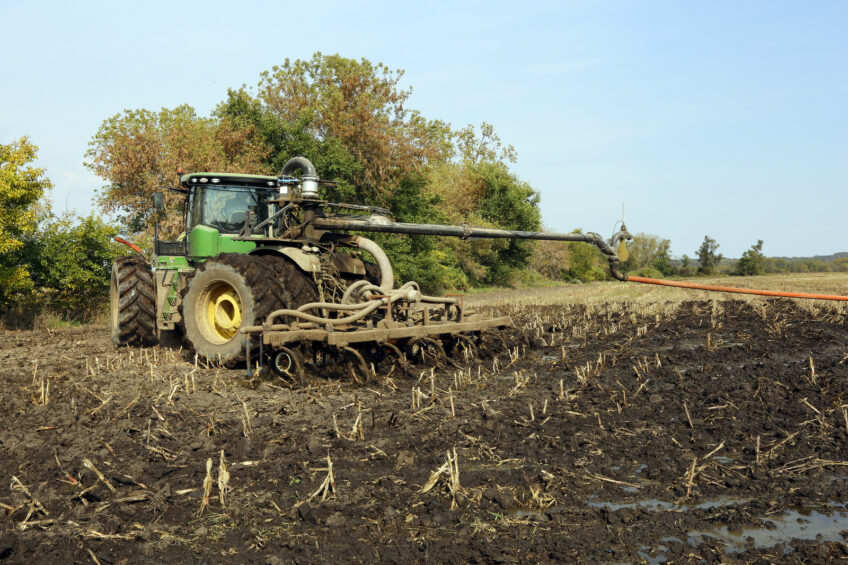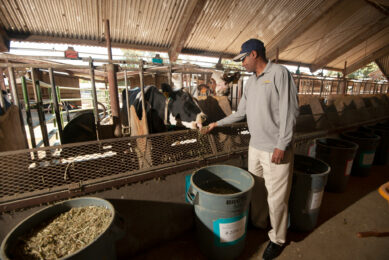Safely Minimising nutrient Waste

Excess nutrient waste from livestock production is a growing concern. The acceptance of reducing dietary crude protein will continue to grow as nutritionists and producers become more confident with ?technologies such as rumen protected amino acids.
Protein (nitrogen) is one of the main components needed to support milk production and growth in dairy cattle. Because of its importance, dairy cattle diets have traditionally been formulated to provide a greater amount of protein to ensure nitrogen does not limit performance. This approach likely resulted in an oversupply of nitrogen and subsequently, some loss through the faeces and urine. As a result, there is now growing concern among many environmental advocates about the negative effects of excess nitrogen on ecosystems, climate, human health and wildlife.
Although there is a great deal of debate about how much production livestock contributes to this problem, agricultural leaders have taken a proactive approach regarding this issue. Nutritional strategies that minimise the amount of nitrogen supplied but still support production are being investigated and promoted by dairy industry leaders. A 2012 report from The Ecological Society of America suggested that nitrogen loss from farm and livestock operations can be reduced 30-50% using current technologies and up to 70-90% with innovative applications of existing methods.
Match cattles’ nitrogen requirements with supply
One approach to minimise nitrogen loss or waste in dairy cattle diets is to try to closely match nitrogen requirements with the nitrogen supplied. In ruminants, the combination of protein from feed sources and microbial growth is used as the protein source. This is sometimes referred to as metabolisable protein. Ruminal fermentation either degrades or alters feed protein and as a result, the amount and type of protein that a ruminant consumes is different from what is available at the small intestine. Additionally, the contribution of bacterial protein to the small intestine is dependent on several other factors such as dry matter intake, types of feed and other dietary components. This makes it difficult to accurately predict the flow of bacterial protein to the small intestine.
Recent advancements in our understanding of ruminant physiology and nutritional modelling have resulted in more accurate estimates of ruminal microbial growth and fermentation. Small changes in ingredients or dietary formulation can now be accurately estimated using some of the models like the CNCPS (Cornell Net Carbohydrate and Protein System). This provides opportunities for nutritionists to formulate for more precisely targeted nutrient concentration, including nitrogen, and still be confident that performance will not be negatively affected. Nutritionists have already started taking advantage of this improved understanding. For example, lactating dairy cow diets have traditionally been formulated to contain between 17-18% crude protein. The adoption of new technologies and techniques has made it possible for lactating diets to be formulated to contain as little as 15% crude protein and still maintain performance.
Improve nutrient utilisation through amino acids
One of the new technologies that may help improve nutrient utilisation is rumen protection of amino acids. In this technology, a nutrient such as an amino acid is either embedded or encapsulated in a matrix (typically a fat matrix) designed to be resistant to ruminal bacterial degradation. This provides the opportunity to feed a nutrient and be confident that it will not be degraded or altered by the time it reaches the small intestine. The concept of protecting nutrients from ruminal degradation by using rumen encapsulation technology is not new and has been used for several decades. However, because of the previously mentioned concerns regarding excess nitrogen, as well as interest in reducing feed costs, there is more incentive by industry leaders to develop additional techniques for producing rumen protected products.
The efficacy of these products allows nutritionists to formulate for lower protein diets and has been demonstrated to be effective in university studies. A presentation was given at the 2014 Joint Annual Animal and Dairy Science Meeting that reported the results of a study in which lactating Holstein cows were fed diets with either elevated crude protein amounts or diets formulated to contain less crude protein and rumen protected lysine and methionine. Four treatments were evaluated: 1) high protein and high metabolisable lysine; 2) low protein with blood meal; 3) low protein formulated with rumen protected lysine and methionine; and 4) low protein formulated with rumen protected lysine and methionine to provide less metabolisable lysine. The dietary crude protein ranged from 17.73% for the high crude protein diet down to 16.16% for the low protein diet. Two commercially available forms of rumen protected lysine and methionine (LysiPEARL and MetiPEARL; Kemin Industries, Inc. Des Moines, IA) were used to provide rumen protected amino acids. Blood meal was used because where available, it is commonly used to provide metabolisable amino acids.
No statistically different milk production parameters
Energy corrected milk averaged 39.76 kg across all the treatments and was not different between treatments. Similarly, the averages for protein yield (1.23 kg) and fat yield (1.39 kg) between the treatment groups were not statistically different. This demonstrated that crude protein concentration can be reduced and still maintain performance. Additionally, dry matter intake for cows fed the treatments providing metabolisable lysine and methionine through either blood meal or rumen protected lysine and methionine had less dry matter intake while still maintaining milk production. This resulted in a significant improvement (Figure 1) in energy corrected milk and feed efficiency (energy corrected milk/dry matter intake).
So, how does an improvement in feed efficiency relate back to reducing the environmental impact of excess nutrient loss? First of all, it should be pointed out that feed efficiency is a valuable number, but it should be evaluated carefully. Other conditions related to management, genetics, ration, and environment can have an impact on feed efficiency. Additionally, improved feed efficiency does not necessarily mean that a dairy is more profitable. Cost of dietary ingredients and price of milk need to be considered when deciding if a change in feed efficiency is making the dairy more or less money.
Significant reduction in nitrogen and phosphorus
However, according to a Penn State University extension, an improvement in feed efficiency does relate to a reduction in manure produced as well as nitrogen and phosphorus output (Tables 1 and 2). The authors calculated the potential reduction based on a cow weighing 612 kg and producing 36.28 kg of milk. Estimated manure and nutrient excretion was calculated from ASAE Bulletin D384.23.
Least square means for energy corrected milk feed efficiency from the recent university study ranged from 1.53 for the high protein diet to 1.59 for the low protein diets formulated to provide similar amounts of metabolisable lysine and methionine. Using the values in Tables 1 and 2, it can be estimated that based on the improvement in feed efficiency, each cow will produce approximately 372 kg less nitrogen and 120 kg less phosphorus per cow per year. Multiply this value by each cow in your herd and the values become very significant.
Join 13,000+ subscribers
Subscribe to our newsletter to stay updated about all the need-to-know content in the dairy sector, two times a week.











